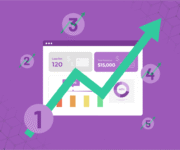The renowned marketing and customer experience guru Jay Baer once said, “We are surrounded by data, but starved for insights”. This suggests that despite having easy access to large pools of data, many businesses do not have the means to extract relevant insights from it. We could see a similar theme across the global lending sector, and the arrival of cloud-based loan management software addresses this glaring challenge.
For example, around 54% of respondents of a McKinsey survey suggested that they are likely to shift at least 50% of their workload to the cloud in the next five years. The results indicate that there is a strong inclination toward leveraging cloud-based and AI-driven solutions to improve the efficiency of various functions in the world of finance.
This article sheds light on the benefits of a cloud-based loan management software and how lenders can harness real-time reporting and analytics to improve decision-making.
Lenders Look to Capitalise on Increasing Demand for Data-driven Credit Distribution
The interdependence of customers and service providers on digital channels, particularly in the retail segment, has witnessed exponential growth in recent years. As a result, the overall dynamics of the lending market have evolved across the world, boosting the adoption of data-driven credit distribution.
Additionally, data-driven credit distribution has also improved profitability and will play a huge role in reshaping the traditional work patterns within the lending sector.
In the following section, let us dive deeper into understanding how real-time reporting and data insights offered by cloud-based loan management software can make a positive impact on loan processing and associated processes.
4 Ways Cloud-Based Loan Management Software Assists Lenders
There are a few key areas where cloud-based loan management is likely to make a huge impact. These include determining a borrower’s creditworthiness, streamlining loan processing, and improving the overall customer experience. Let’s examine each of these benefits in detail.
1. Determining the Borrowers’ Creditworthiness
Determining the creditworthiness of a borrower is one of the preliminary steps of the lending process. Additionally, the value of loans primarily depends on the individual’s or the business’s ability to repay the loan.
Despite having all the relevant and accurate information, many lenders find it challenging to process loans as they are unable to cross-check the information provided by the borrowers. This is where the blend of artificial intelligence (AI) and cloud computing comes into play.
Traditionally, lenders relied on a few metrics, including the income and FICO score of the borrower. Today, lenders are looking at additional parameters, such as the borrower’s entire transaction history and digital footprint, to assess their ability to repay the loan.
Many lenders refer to this data as “alternative data”. This additional data can be used to measure the borrower’s creditworthiness, especially if they do not have a credit history and also gain deeper insight into borrowers with established FICO scores.
2. Accelerating and Streamline Loan Processing
There is little doubt that implementing new and better ways to assess a borrower’s creditworthiness is an effective way for lenders to attract new customers and scale their business. That said, lenders are increasingly seeking efficient ways to reduce overhead costs and delays to maximise profits for every loan.
Typically, lenders have relied on computers to automate different aspects of loan processing. However, the tide is gradually shifting as almost all lenders are looking to automate loan processing and management fully.
The advent of new solutions, including cloud-based loan management software, enables lenders to fast-track loan processing and improve efficiency simultaneously. The valuable data provided by loan management solutions automate mundane and time-consuming activities, including document verification, compliance checks, and data entry, enabling lenders to focus on other important tasks.
Therefore, a cloud-based loan management software streamlines the entire loan process, minimising the need for manual intervention and reducing the chances of delays.
3. Relevant and Detailed Customer Profiling
The data analytics capabilities of cloud-based loan management solutions forge the way to create more relevant and detailed customer profiles. This, in conjunction with trading and transactional analytics, can assist lenders in acquiring and retaining clients.
Additionally, this data can be further utilised for cross- and upselling. Today, a plethora of established banks are leveraging the credit card transactional data of their customers to create customised offers, provide incentives, and encourage regular purchases from their merchants. This has led to a significant increase in the bank’s commissions and also boosted revenues for its merchants.
Cloud-based loan management solutions’ AI-based machine learning algorithms provide lenders with crystal-clear customer insights. This data enables lenders to create multiple customer profiles and evaluate their likeliness of purchasing loan products.
Moreover, lenders can also formulate targeted marketing campaigns that cater to the requirements of specific customer segments based on behavioural, financial and demographics.
4. Better Fraud Detection
Lenders in the past relied on incompetent prediction models to detect and prevent fraud linked with loans. Today, analytics-aided features, including digital credit assessment, next-gen stress testing, credit-collection analytics, and early-warning systems, are integrated into cloud loan management software.
Furthermore, compliance and control-related expenses have soared over the past few years, so more and more lenders are switching to real-time data analysis.
To tackle this, lenders can employ data analytics methods, including machine learning and anomaly detection algorithms, to identify potentially fraudulent activity or risky loan applications.
They can also reduce the risk of granting fraudulent loans by evaluating various data points and seeing trends that lead to fraudulent conduct, saving time and resources that might otherwise be used for recovery or legal actions.
Bottom Line
Bad loans, fraud, and questionable loan financing will continue to pose a major threat to lenders in the upcoming years. Additionally, increasing pressure from the government and regulators to safeguard customer data is another barrier that could hinder the adoption of cloud-based loan management software.
Despite these hurdles, the benefits of loan management solutions outweigh the negatives and are likely to play a key role in streamlining loan management for years to come. Finezza’s cloud-based loan management software is integrated with advanced features to facilitate smooth and efficient loan management.
Book a demo to know more about our end-to-end loan management solution.




Leave a Reply